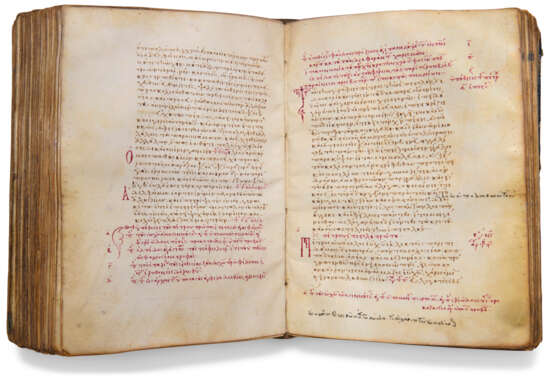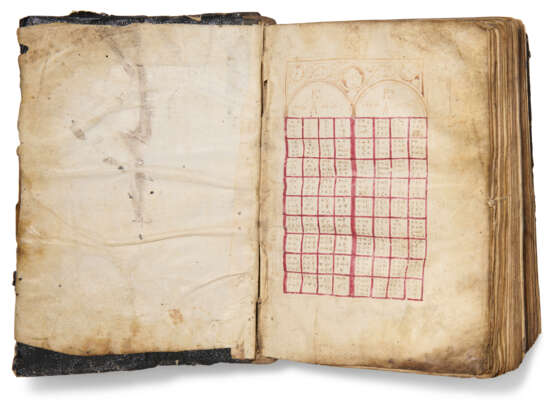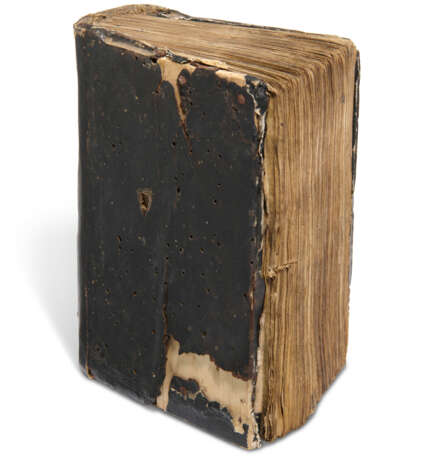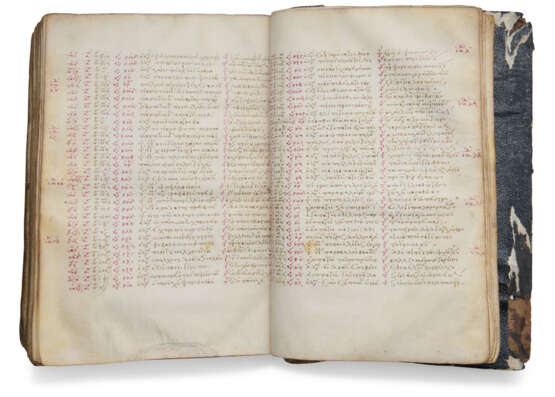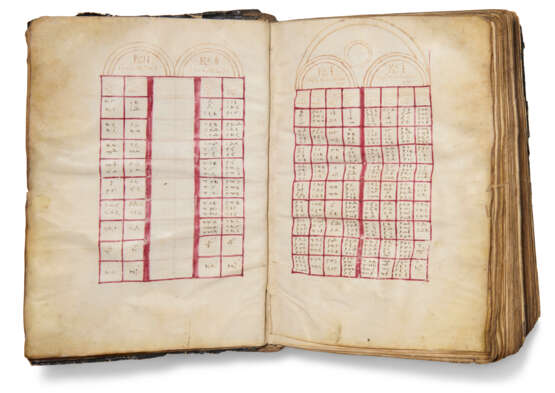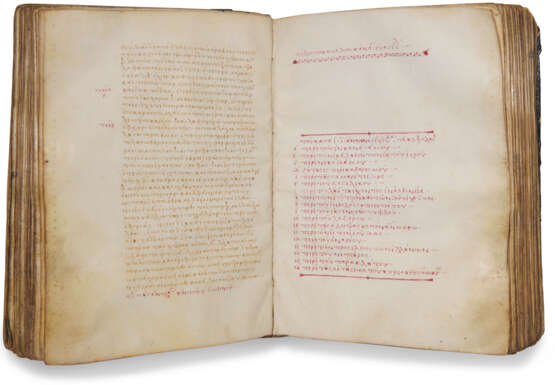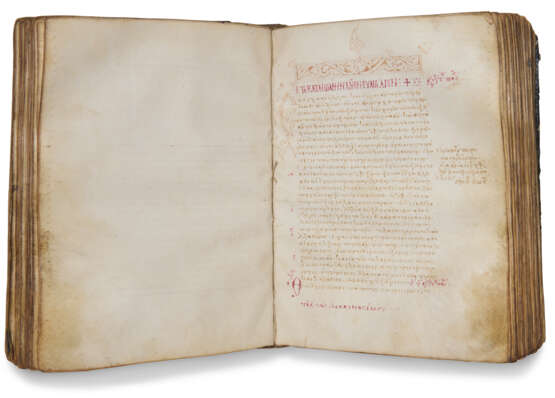ID 1214861
Los 13 | A Greek New Testament from Mount Athos
Schätzwert
£ 60 000 – 90 000
New Testament, in Greek, decorated manuscript on vellum [Monastery of Great Lavra, Mount Athos, 13th century]
A handsome example of traditional scriptural and liturgical manuscript production of the late Byzantine 'Palaeologan Renaissance', from the Monastery of the Great Lavra at Mount Athos, in an early Greek binding.
217 x 154mm. 340 leaves, collation: 11(of 2, ii a cancelled blank), 17, 2-418, 4210, 432, 33 lines written in a handsome Greek minuscule, ruled space: 155 x 95mm, prickings visible, contemporary gathering signatures sporadically survive, traces of sewn bookmark on f.63, rubrics and initials in red throughout, titles in red majuscules, 4 embellished initials marking the beginning of each Gospel in pinkish-brown ink with foliate ornamentation, numerous headbands in red or pinkish-brown ink, some adorned with foliate ornamental patterns (ff.141, 173v, 268v, 291v), 7 leaves with full-page Canon Tables, 3 half-page square headpieces with floral, palm-shaped or geometrical motifs enclosed in round medallions (lacking 2 leaves at the beginning with 3 canon tables, some marginal soiling and cockling).
Binding:
Late medieval Greek brown goatskin over wooden boards, chain stitches on 4 sewing stations, stamped geometrical pattern of 4 rectangles inscribed in a triple fillet frame, spine raised 'alla greca', traces of clasps and of 4 metal bosses, one in each corner (wormholed and worn, lacking small section of front cover, edges scuffed).
Provenance:
(1) The Monastery of the Great Lavra at Mount Athos, Greece. The manuscript is classified in Kurt Aland's Liste (Aland, 1954) as no 2483 (it was later registered as 2866, before Tommy Wasserman spotted the double-listing, see Wasserman, 2006). According to the Liste the manuscript had 8 additional leaves at the end which included an ownership inscription of the Monastery of the Great Lavra at Mount Athos, along with a sale notice in Istanbul, 1925. The manuscript is not apparently recorded in Eustratiades and Spyridon's Catalogue of the Greek Manuscripts in the Library of the Laura on Mt. Athos, 1925, which lists some 120 Gospel books. Great Lavra was the first coenobitic monastery established on Mount Athos, and is the largest of all Athos monasteries, its library containing some 2,000 manuscripts and 165 codices and 30,000 printed books. The manuscript was evidently well used over the centuries, and there are later medieval pentrials and inscriptions on the final leaves. The script of the main text has been linked by a previous cataloguer to a group of manuscripts datable to the second half of the 13th century, including a Tetraevangelon in Paris (Bibliothèque Sainte-Geneviève, MS 3398) dated September 1263. Similar red ink floral ornamental headpieces can be found in another Tetraevangelon in the Karkalou Monastery (Cod.20), datable to 1289-90.
(2) René Bonjean (1891-1967), of Château de Tumejus, Bulligny.
(3) Bruce Ferrini, Akron, Ohio, sold in January 2000 to:
(4) The Schøyen Collection, MS 2932.
Content:
Eusebian Canon Tables ff.2-5; Letter of Eusebius of Caesarea to Karpianos ff.5v-6; Synaxarion tables ff.6v-11; Menologion tables ff.11-17; Gospel of Matthew ff.17-62; Gospel of Mark ff.62v-92; Gospel of Luke ff.92v-139v; Gospel of John ff.140-171v; Acts of the Apostles ff.172-215; Epistle of James ff.215-219v; 1 Peter ff.219v-224v; 2 Peter ff.224v-227v; 1 John ff.227v-233; 2 John ff.233-234; 3 John ff.234-234v; Epistle of Jude ff.234v-236; Epistle of Paul to the Romans ff.236-253; First Epistle of Paul to the Corinthians ff.253-268v; Second Epistle of Paul to the Corinthians ff.268v-279; Epistle of Paul to the Galatians ff.279-284v; Epistle of Paul to the Ephesians ff.284v-290v; Epistle of Paul to the Philippians ff.290v-294v; Epistle of Paul to the Colossians ff.294v-299; First Epistle of Paul to the Thessalonians ff.299-303; Second Epistle of Paul to the Thessalonians ff.303-305v; First Epistle of Paul to Timothy ff.305v-310v; Second Epistle of Paul to Timothy ff.310v-313; Epistle of Paul to Titus ff.313-315; Epistle of Paul to Philemon ff.315v-316; Epistle of Paul to the Hebrews ff.316v-330; Table with Gospel lections for feast days, both fixed and movable, ff.330-339v.
Comparisons have been drawn with the work of the Byzantine scribe and illuminator Theodore Hagiopetrites (on whom see R.S. Nelson, Theodore Hagiopetrites: a late Byzantine scribe and illuminator, 1991), whose work spans the final third of the 13th century. The ornamental designs in the present manuscript are comparable to those found in a New Testament in Meteora (MS 545); a Gospel Book at the British Library, Add. MS 19387; and another in Chicago, University of Chicago MS 727. Nelson suggests that Hagiopetrites might have worked in Thessaloniki, which would throw some light on the close links and collaboration between Thessaloniki and Mount Athos at the end of the 13th century.
Literature
Aland, K., 'Zur Liste der Neutestamentlichen Handschriften. V', Zeitschrift für die Neutestamentliche Wissenschaft und die Kunde der Älteren Kirche, 45, 1954, p.201, no 2483.
Duplacy, J., 'Manuscrits grecs du Nouveau Testament émigrés de la Grande Laure de l'Athos', Studia Codicologica, 1987, p.162.
Wasserman, T., 'MS 2866=2483–sold by Ferrini, registred twice', Evangelical Textual Criticism, blogpost, 18 April 2006.
Wasserman, T., 'The Epistle of Jude: its Text and Transmission,' Coniectanea Biblica, New Testament series, 43, 2006, p.120.
Wasserman, T., 'Some Bibliographic Notes on Greek New Testament Manuscripts', Novum Testamentum, 49, fasc. 3 (2007), p.295.
| Herkunftsort: | Griechenland, Europa |
|---|---|
| Kategorie des Auktionshauses: | Handschriften des Mittelalters und der Renaissance, Bücher und Handschriften |
| Herkunftsort: | Griechenland, Europa |
|---|---|
| Kategorie des Auktionshauses: | Handschriften des Mittelalters und der Renaissance, Bücher und Handschriften |
| Adresse der Versteigerung |
CHRISTIE'S 8 King Street, St. James's SW1Y 6QT London Vereinigtes Königreich | |
|---|---|---|
| Vorschau |
| |
| Telefon | +44 (0)20 7839 9060 | |
| Aufgeld | see on Website | |
| Nutzungsbedingungen | Nutzungsbedingungen |
